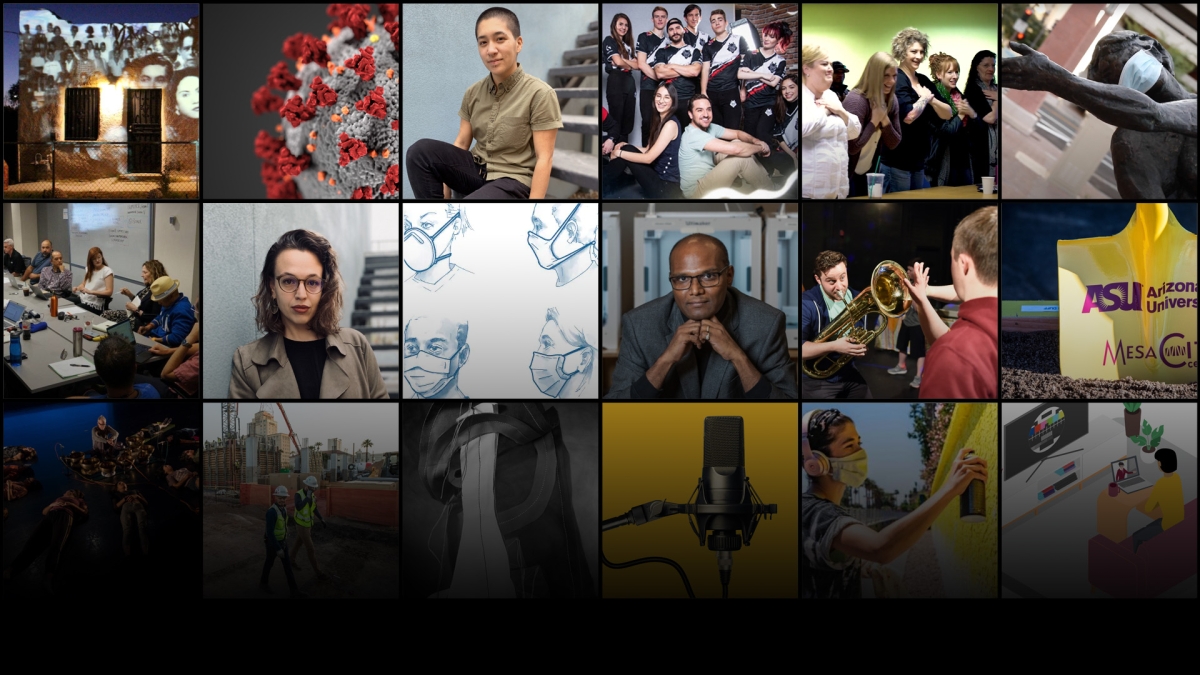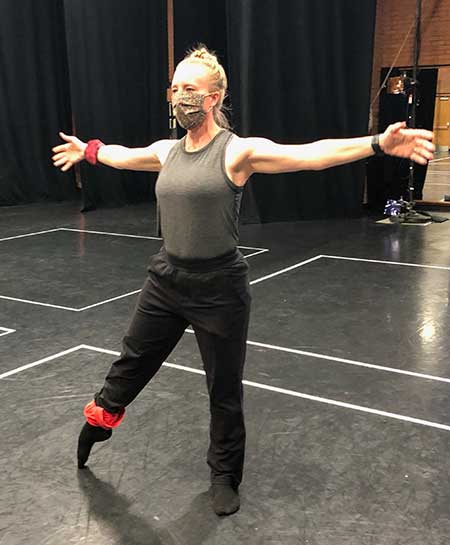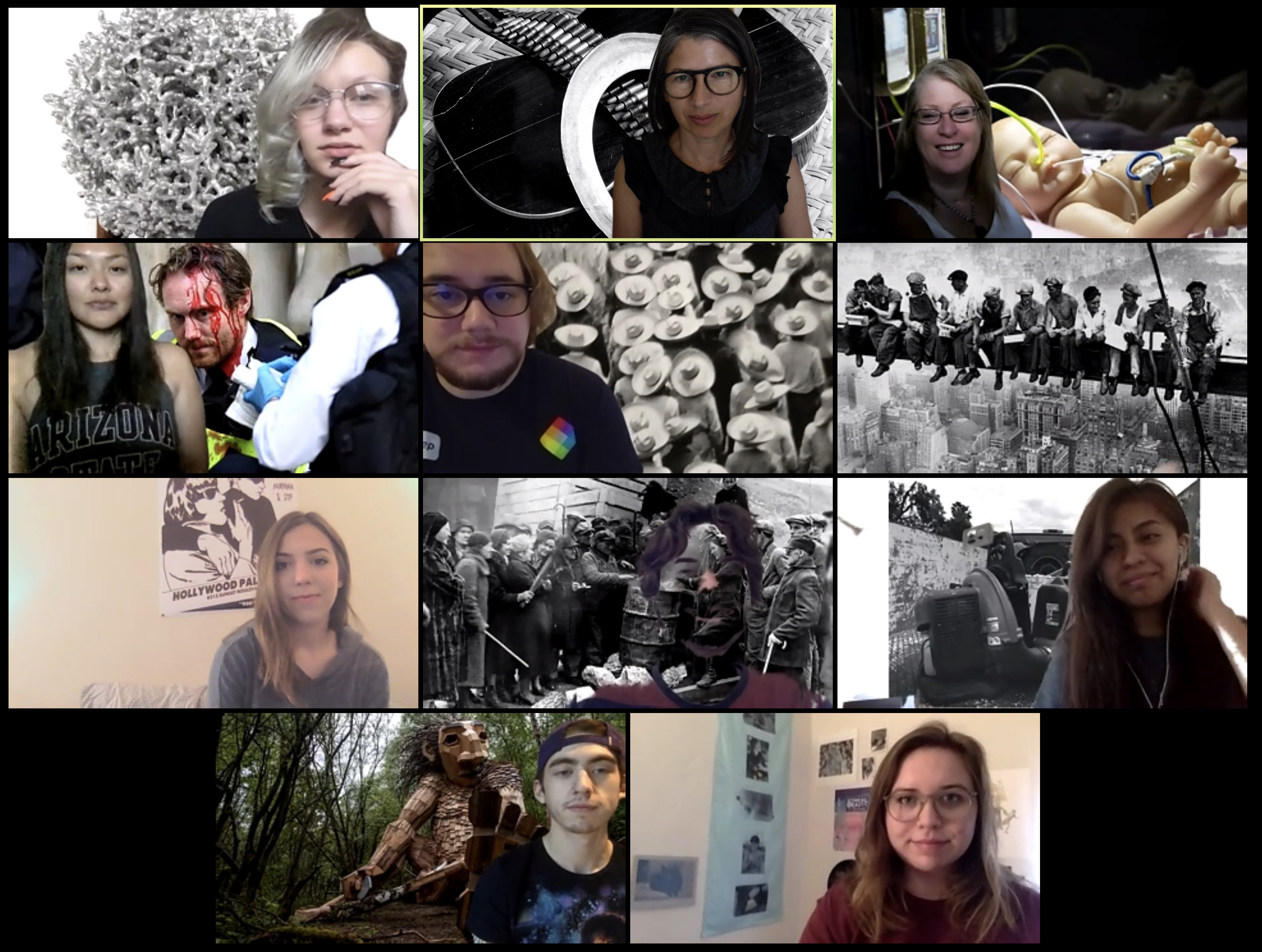Creativity required: How COVID-19 accelerated change in design and arts education

Liz Cohen wasn’t eager to teach online. The Guggenheim-winning associate photography professor, who considers herself a people person, didn’t think it was for her.
When COVID-19 happened, Cohen threw herself into figuring out “how to use this (ASU SyncASU Sync is synchronous, technology-enhanced and fully interactive remote learning using live lectures via Zoom. This approach can be used simultaneously with in-person instruction to accommodate students in different circumstances and enable physical distancing in classrooms or as stand-alone technology. It offers the benefits of face-to-face instruction in an interactive group learning environment. ASU launched this teaching format for the fall 2020 semester, after pivoting to all-remote learning in the spring when the pandemic hit.) platform in ways that are interesting.”
To her surprise, she said, “I like it. COVID has taught us something — not that I’m going to give COVID too big a pat on the back.” She appreciates the “dynamic relationship” between herself and the students — "there’s banter, and everyone’s engaged”—and she likes the ease and convenience of teaching via ASU Sync.
On Zoom, Cohen requires each student in her photography studio on labor and representation to use a different background related to that topic, which the student explains to the group.
“It’s a great way for me to assess where they’re at,” Cohen said. “And we learn about labor movements around the world.”
Many of her students are also fans of the platform. Zonnie Notah-Begay, a senior in Cohen’s class, says she actually prefers ASU Sync learning in some ways.
“I am really a shy and introverted person who doesn't like interacting with anyone,” said Notah-Begay. “The computer provides another wall for me to keep that boundary up.”
Paradoxically, Notah-Begay says that ASU Sync has helped her talk and engage more than she would in person.
“Liz's class is a studio class, which means there are critiques, and Sync has helped me be more involved. In in-person critiques I am very quiet and rarely give my feedback, which is a shame.”
ASU School of Art Associate Professor Liz Cohen leads her labor and representation students via Zoom. Cohen requires each student in her photography studio to use a different background related to that topic, which the student explains to the group.
Alice Buyer, also a senior in Cohen’s class, does miss human interaction. But she says there’s a lot about ASU Sync learning she likes, especially not having to commute to campus anymore.
“Parking passes on campus are very expensive, and riding my bike to campus feels like a chore when it’s so hot. I really love that I can get out of bed, make my coffee and sit on my couch to attend class.”
“I think I was surprised at how well (ASU Sync) actually works,” Buyer said. “I was surprised at how well everyone was able to make the technology aspect work. All of my professors picked up on how to utilize the technology fairly quickly for a smooth experience.”
“We’ve been at the forefront of teaching design and arts online, and we’ve been pushing ourselves to do more in that arena,” said Herberger Institute Dean Steven J. Tepper, who points to Betsy Fahlman in art history and Max Underwood in architecture as two pioneers of online learning in the institute. In 2018, the School of Art launched its online digital photography degree, one of the first in the country.
Even so, Tepper said, “We certainly didn’t anticipate having to move 1,000 courses online in five days, which was what happened in March. That experience pushed us to recognize that a lot of what we do can in fact be done through technology, because creativity doesn’t exist in a specific tool or a technology — it’s in whatever idea we can conceive of and develop. And the moment we’re in forces us to be creative and really use that muscle.”
Looking back at the spring, Joe Burgstaller, world-renowned trumpet player and associate professor in the School of Music, Dance and Theatre, described the jump to online as “an adaptation to online where we accomplished everything that we had planned for in-person.” He calls the current semester “an aggressive plan taking full advantage of this specific modality.”
Burgstaller and his colleagues spent the summer figuring out how to fully leverage the technology and use it to their students’ advantage. As an example, the brass faculty released a video of their virtual performance of the “Love Theme to Cinema Paradiso, ” produced using only resources that are free to ASU students, such as BandLab and Adobe Creative Suite.
“COVID is not decelerating your learning process — it’s reordering it,” Burgstaller said. “We’re in this situation where we can make a lot of difference in helping students learn technology skills that are usually acquired later or once musicians are out of school. In my era as a student, these are all skills I learned on my own and use intensively.”
Burgstaller also noted that in-person ensemble skills will be “greatly enhanced” this semester. Under typical circumstances when playing in-person, faculty encourage students to record their sessions so that they can listen back and more effectively understand what to refine and how to implement what they are learning. Now, using this collaborative recording-studio technology, students are passing their recordings back and forth, building a virtual ensemble from the ground up and gaining a different depth of understanding.
“They’re taking ownership,” Burgstaller said of the students, “which is really what we want. The teaching dynamic is a partnership. This situation is enhancing their power and agency.”
For this Happy Birthday Project, ASU trumpet students Mason Christofferson, Gage Ellis, Taylor Hubbard and Joel Uliassi perform together virtually, arranged by Hubbard.
Another perk: Former students who have “made it” in the music world can Zoom in to talk to Burgstaller’s class more readily.
“This would not have happened with this frequency under normal circumstances,” Burgstaller said. “We’d have guests, but not access to as many guests and not as often. And with the guests, students are getting an opportunity to immediately address what's going on in the world.”
Dellan Raish, who graduated in the spring with a bachelor's degree in architectural studies and is currently a student in the master's degree program, said the special guests were one of his favorite aspects of the ASU Sync learning experience. For the final-review Zoom call in his studio with Marc Neveu, director of the architecture program in The Design School, “the students were able to receive valuable critiques from reviewers all over the world, which would not have been possible outside of Zoom. Another benefit was the ability to record the meeting and watch back your presentation and all the comments you received. This helps tune your project and presentation skills for future reviews.”
Raish also appreciated the reduced travel time to and from the studio.
“Without having to take an extra 30 minutes to and from class, I was able to spend more time working on projects. An extra hour each day cut out of travel time was immensely beneficial to my schedule, with the important benefit of reducing carbon emissions,” he said.
Neveu is a long-time advocate of new approaches to teaching architecture, in a discipline that he says was slow to change.
“In architecture, the idea of the studio, the lecture, these are things that are just embedded in our academic culture,” he said. “When I was in school, the default setting was you go to studio from 1 to 6, and then you’re there till 2 in the morning.” Today, he says, when students work more and may have families of their own, that model doesn’t work as well.
“When (the pandemic) happened, we had the ability to question things we had always taken for granted,” Neveu said. “Now all of a sudden, you're looking at a Zoom call, and you’ve got 16 students looking back at you. You can't sit there for five hours. It just doesn't work.”
Beyond the Zoom grid: ASU School of Music’s Joe Burgstaller, John Ericson, Brad Edwards and Deanna Swoboda perform “together” thanks to technology.
Neveu echoes Tepper’s assertion that design and arts education is about teaching people how to think creatively.
“A good architect can frame problems in new ways: How does this work? How can I fix it? Our job isn’t just to tell people about architecture, but it’s really about a way of thinking. I think the spring semester was a way of bracing ourselves, but there’s a silver lining in this. After the pandemic, the architecture program voted unanimously to go forward with a professional online program. Before that, we were talking about how we could teach history or software online — but not studio.”
Cynthia Roses-Thema, a principal lecturer in dance in the School of Music, Dance and Theatre, is also an advocate of teaching design and the arts in an online environment. She has taught dance online at ASU for nine years.
“The stumbling block sometimes is that teaching creativity requires digital tools and learning systems that are more open and flexible to potential and possible outcomes rather than fixed right answers,” Roses-Thema said. “With each new digital tool that ASU provides there are more creative possibilities, but I feel we are only at the beginning.”
Roses-Thema said because so many of ASU’s dance alumni teaching in the Arizona public schools had already experienced dance online as students, unlike other dance teachers they “were not frightened to transfer dance online.”

Carley Conder, clinical assistant professor of dance, teaches postmodern dance to students both in the studio and via Zoom. She wears scrunchies on her right wrist and right ankle to make it easier for the students online to be sure of right and left.
Carley Conder, clinical assistant professor of dance in the school and founder of the company CONDER/dance, has made several adaptations in teaching postmodern dance in hybrid fashion, which means a portion of the students are online and a portion are in person for any given class period. Those adaptations include a complex sound configuration, the result of troubleshooting by dance faculty for almost a month before classes started in the fall, that includes students in the studio (masked and physically distanced), students on Zoom and a remote musician; wearing a scrunchie on her right wrist and right ankle so that online students can easily determine right from left, and devoting the last 10 minutes of the class to the online students.
For David Olarte, also a clinical assistant professor in dance and an expert in Latino social dance, the challenge of teaching a hybrid class is multiplied. Typically, he said, there might have been 80 students in a studio for a salsa class, dancing in pairs; today there are about a dozen, each one inside a 12-foot square so dancers can remain at least 6 feet away from each other, plus another dozen students on Zoom.
“We’ve had to reimagine and relook at how we view partnering this whole semester," Olarte said. "We look at self as partner and focus on elements we use in partnership. We look at how we’re using our footwork, how we’re interpreting musicality. We still have to have meaningful connections, but now it’s about learning how to project and connect without physical touch.”
During a virtual town hall for New American Film School students in August, faculty members explained that the ways students are having to create in this moment mirror the ways professionals in their field are doing it. Because the pandemic is global, artists around the world, at every level, are being forced to figure out new ways to make and present their work. (Who could have predicted a virtual Emmys ceremony, with celebrities accepting awards in their own homes?)
Film is usually very collaborative — think cast and crew on a set — which means it requires very different approaches to production now that people need to be physically distanced. But as Andres Torres, an award-winning filmmaker who is a professor of practice, told students, “If you focus on what you don’t have, you never make anything. If you focus on what you do have — more access to faculty, more flexibility with faculty — you can do great things. That’s what creativity is. We can talk about limitations, but there are also all these challenges we can use to make great art.”
More Science and technology

ASU and Deca Technologies selected to lead $100M SHIELD USA project to strengthen U.S. semiconductor packaging capabilities
The National Institute of Standards and Technology — part of the U.S. Department of Commerce — announced today that it plans to award as much as $100 million to Arizona State University and Deca…

From food crops to cancer clinics: Lessons in extermination resistance
Just as crop-devouring insects evolve to resist pesticides, cancer cells can increase their lethality by developing resistance to treatment. In fact, most deaths from cancer are caused by the…

ASU professor wins NIH Director’s New Innovator Award for research linking gene function to brain structure
Life experiences alter us in many ways, including how we act and our mental and physical health. What we go through can even change how our genes work, how the instructions coded into our DNA are…
